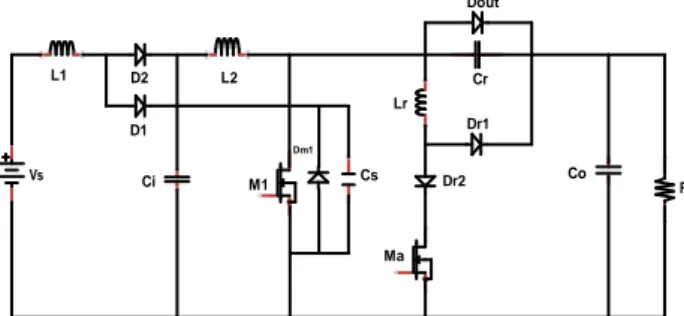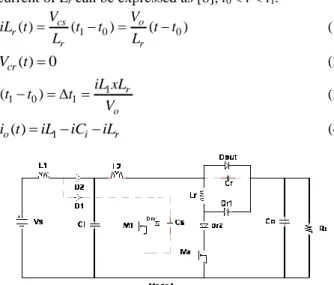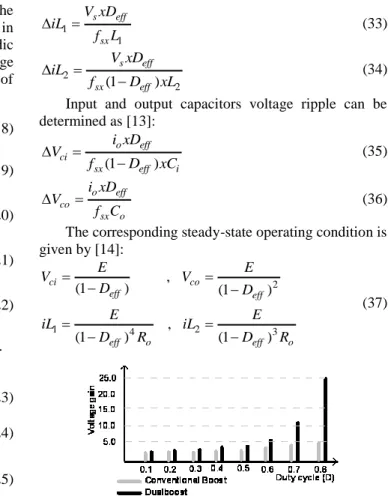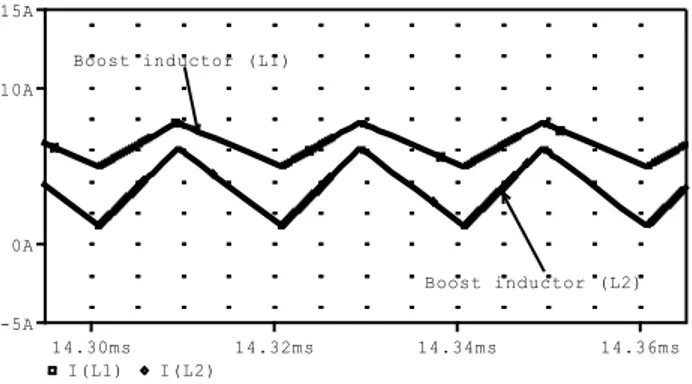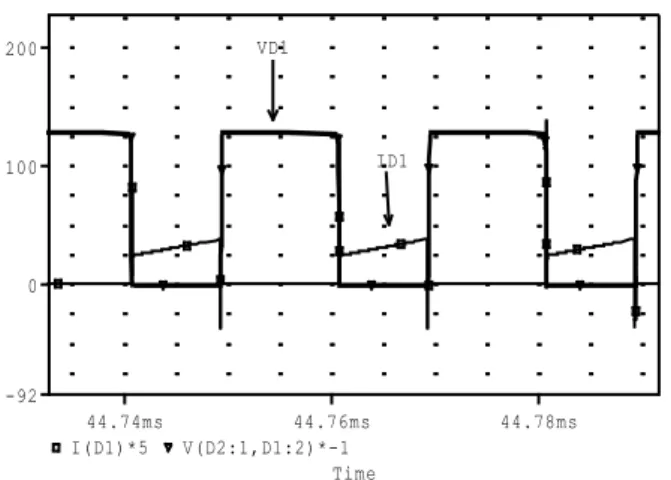“Technical and Physical Problems of Engineering”
(IJTPE)
Published by International Organization of IOTPE
IJTPE Journal
www.iotpe.com
ijtpe@iotpe.com March 2015 Issue 22 Volume 7 Number 1 Pages 65-71ANALYSIS OF A SOFT SWITCHED DUAL-BOOST CONVERTER
H. Donuk
1I. Iskender
2N. Genc
31. Electrical Engineering Department, Sirnak University, Sirnak, Turkey, hakan.donuk@gmail.com 2. Electrical and Electronics Engineering Department, Gazi University, Ankara, Turkey, iresis@gazi.edu.tr 3. Electrical and Electronics Engineering Department, Yuzuncu Yil University, Van, Turkey, nacigenc@gmail.com
Abstract- This paper proposes a soft switched dual-boost
converter using an auxiliary resonant circuit. The topology is composed of a general dual-boost converter and an auxiliary resonant circuit including one switch, inductor, capacitor and two diodes. The auxiliary resonant circuit helps the main switch to operate under ZVT condition. The auxiliary switch is also operated at soft switching mode. Furthermore, the proposed circuit removes the voltage stress on the main and auxiliary switches. Under soft switching conditions the efficiency of the converter increases. The converter has various advantages compared with the conventional boost converters as higher boost rate with low duty cycle, lower voltage stress on components and higher efficiency.
Keywords: Zero Voltage Transition, Dual-Boost
Converter, Boost Converter, Soft Switching.
I. INTRODUCTION
DC-DC converters controlled by Pulse Width Modulation technique have a wide range of application areas. Operating the converter at high frequency decreases the converter volume and increases the power density of converter. However, increasing the operating frequency increases the switching losses and the Electromagnetic Interference (EMI) resulting reduction in efficiency of converter [1]. Basically, switching losses are composed of switching losses of switches due to overlapping of voltage and current, loss of diodes due to reverse recovery phenomenon and discharge loss of the parasitic capacitor [2].
To reduce the switching losses several suppressing cells are made as RC/RCD, polar/non-polar, resonance/non-resonant and active/passive cells. The switching losses are greatly reduced by zero voltage switching method (ZVS) and the zero current switching (ZCS) method. There have been published many papers about boost converter with active soft-switching methods. Boost type converter switching at zero voltage (ZVT) is one of the soft switching techniques given in [3]. There are methods given in [3], [4] and [5] in which the snubber cells cannot eliminate all the switching losses.
In [5-7] there are used multiple inductors that increase the volume and decrease the power density of the converter. Soft switching techniques used in [6] and [8]
reduces the losses but cannot remove the voltage stress of main and auxiliary switches. The turn on and turn off losses are reduced in [9], but due to several numbers of elements the volume of the converter increases. There is another study [10] in which auxiliary switch is used for soft switching. In the study given in [11] the active snubber circuit provides zero voltage transition modes for the main switch. There is no voltage and current stress on the main diode.
This paper proposes a soft switched dual-boost converter that is able to turn on both the active power switches at zero voltages to reduce their switching losses and evidently raise the conversion efficiency. In the study dual-boost converter circuit is operating under soft switching technique and the efficiency of the converter increases by reducing the switching losses. The problem of voltage stress is also eliminated. The operation principles of the converter and the conditions for realization of soft switching are analyzed in detail, simulation analysis performed using PSpice is given. The simulation results show that all the switches are operating at soft switching state and the efficiency of the converter is improved.
II. CIRCUIT CONFIGURATION
Figure 1 represents the circuit configuration of the proposed dual-boost pulse width modulation (PWM) converter.
Figure 1. Proposed soft switched dual-boost DC/DC converter The converter consists of one switch; two boost inductors L1 and L2, two diodes D1 and D2, and capacitors
Ci and Co. Except the output capacitance of the converter, the other components of the converter constitute the auxiliary circuit. Ma, Dr1, Dr2, and Dout represent the
L1 Vs L2 Lr Ci Co Cr Cs Ro Ma Dm1 M1 D2 D1 Dr2 Dr1 Dout
auxiliary switch and diodes, respectively. The Lr and Cr present the inductor and capacitor of proposed auxiliary circuit, respectively. The Dm1 is the intrinsic parallel diode of MOSFET M1 and the snubber capacitance, Cs is common for the main switch M1.
III. CIRCUIT OPERATION ANALYSIS
The following assumptions are made in analysis of the converter.
The output capacitor Co is large enough to neglect reasonably the output voltage ripple and consider a constant level output voltage.
The forward voltage drops on MOSFET M1, Ma and diodes D1 and D2 are neglected.
Inductors L1 and L2 are large and equal.
The components of the converter are ideal.
The active switch, M1 is operated with pulse width
modulation (PWM) control signals. This is gated with identical frequency and duty ratio. The operation of the converter can be divided into seven modes, the equivalent circuits and the theoretical waveforms are illustrated in above figures.
A. Mode 1
Prior to this mode, the main switch M1 and the
auxiliary switch Ma are in the off state and output diode Dout is conducting. At the beginning of this mode, Ma is turned on. The resonant inductor (Lr) current starts to rise through the path of Vs L1 L2LrMa
.
Since the rise rate of this current is limited by Lr, the devices D1 and Ma are turned on under soft switching. The voltage across Csis nearly equal to the output voltage (Vo) in this interval and the initial voltage across the Cr is nearly equal to zero. During this time interval, the voltage across Cr and current of Lr can be expressed as [8], t0 < t < t1.
1 0 0 ( ) cs( ) o( ) r r r V V iL t t t t t L L (1) ( ) 0 cr V t (2) 1 1 0 1 ( ) r o iL xL t t t V (3) 1 ( ) o i r i t iL iC iL (4)
Figure 2. Equivalent circuit scheme of the operation mode 1 (t0< t <t1)
B. Mode 2
Ma current reaches iL1 and output current falls to zero at t = t1. The snubber capacitor (Cs) begins to discharge and the current in Lr increases because of the resonance between Lr and Cs. Cs is discharged until its voltage reaches zero at t2. The resonant time period of this
interval, current of Lr and voltage across Cs are given by t1 < t < t2. 1 1 ( ) o*sin ( ) r V iL t iL t t Z (5) 1 ( ) cos ( ) cs o V t V
t t (6) 2 1 2 ( ) 2 r s t t t L C (7) where, 1 r s L C and Z LrCs.Figure 3. Equivalent circuit scheme of the operation mode 2 (t1< t <t2)
C. Mode 3
At t = t2, the main switch and D2 are in the off state
and auxiliary switch and D1 are in the on state. Auxiliary
switch conducts the current in Lr. As seen from the Figure 9 at the beginning of this mode current of snubber capacitor Cs is completely exhausted and the Lr current reaches its maximum rate. At this interval, the current in Lr flows in Lr-Ma and body diodes of the main switches. The voltage across Cr is discharged nearly to zero before t2. The maximum current of Lr can be equated as [8]:
max 1 ( ) / r r L o iL t iL i V Z (8) ( ) 0 cr V t (9)
At this mode, the main switch should be switched to satisfy the ZVT condition. By assuming the average inductor current of L1 is the half of the input current at
steady state, delay time for M1, td can be expressed as [8]: 1 2 2 in r d r s o i xL t t t L C V (10)
Additionally, the current through inductors will start to increase linearly according to:
1 3 2 3 2 1 1 ( ) ( ) s s r V V iL t t t t L L L (11) 2 2 2 ci ci r V V iL t t L L L (12)
D. Mode 4
As seen from the Figure 5 at the start of this interval, Ma is turned off and the main switch is turned on at the same time. At this mode, the main switches, M1 and Lr conduct the input current together. At the end of this mode the current of Lr andL1, L2 reaches zero [12].
1 4 3 4 3 1 1 ( ) ( ) s o s r V V V iL t t t t L L L (13) 2 6 4 2 ( ) ci V iL t t L (14)
Figure 5. Equivalent circuit scheme of the operation mode 4 (t3< t <t4)
E. Mode 5
This interval is composed of two equivalent circuit. The energy is stored in the boosting inductor L1 through
the loop of Vs-L1-D1-M1 and stored in the boosting
inductor L2 through the loop of Ci-L2-M1. The energy is
transferred to the load through discharging capacitor, Co. The current of L1: 1 5 4 1 ( ) s V iL t t L (15)
Figure 6. Equivalent circuit scheme of the operation mode 5 (t4< t <t5)
F. Mode 6
At t5, the current of main switch falls to zero and
voltage across of M1 and Cs go up to output voltage Vo. At the end of this interval, the current of Lr starts to increase.
Figure 7. Equivalent circuit scheme of the operation mode 6 (t5< t <t6)
G. Mode 7
At a certain moment t6, D2 and main switch are turned
off. D2, Dr2 and Dout are turned on. The inductor currents IL1 and IL2 at that moment have reached peak values. The stored energy is supplied to load through diodes D2, Dr2 and Dout. As a result, the current through the inductors IL1 andIL2 will start to decrease linearly according to [12]:
1 6 7 1 ( ) s ci V V iL t t L (16) 2 6 7 2 ( ) ci o r V V iL t t L L (17)
Figure 8. Equivalent circuit scheme of the operation mode 7 (t6< t <t7)
Current Ci is inversed again, and Ci is now charging until D1 is turned on again and the cycle with its seven
intervals is repeated.
Figure 9. Theoretical waveforms of the proposed circuit topology IV. CIRCUIT DESIGN AND SELECTION OF
COMPONENTS
The dual-boost converter is a high-efficiency step-up DC/DC switching converter. The converter uses a switch to transfer power through pulse-width modulation technique.
This section presents a design procedure for the proposed soft switched dual-boost converter operating in continuous conduction mode (CCM). In the periodic switching scheme with period T, the average voltage across the first inductor must be zero. The relationship of voltage and current for first inductor is as [12]:
1 1 1 L L di V L dt (18) 1 0 1 1 1 1 ( ) t ( ) (0) L L L I t V t dt I L
(19) 1 1 1 1 1 ( ) t ( ) ( ) L to L L o I t V t dt I t L
(20) 1 0 0 1 1 1 1 ( ) T to ( ) ( ) L t L L o I T t V t dt I t L
(21) 1 0 1 0 1 1 1 ( ) ( ) T to ( ) L L t L I T t I to V t dt L
(22) where, IL1( )t I T( t), tt0, 1 1 0 1 1 ( ) T t ( ) 0 L t L V t V t dt L
.According to the voltage second product:
( ) or ( ) s on ci s off s ci off V t V V t V T V t (23) ci s s off on T T V V V t T t (24) 1 1 ( ) ci s aux main V V D D (25)
where, Deff = Daux + Dmain, Dmain is duty cycle of the main switch and Daux is the duty cycle of the auxiliary switch.
The same procedure is used to find the relation between output voltage Vo and the first stage output Vci:
(Vci)ton(VoVci)toff (26) ( ) ( ) ci on off o off V t t V t (27) o ci ci off on T T V V V t T t (28) 2 1 1 1 ( ) (1 ) o ci s
aux main aux main
V V V D D D D (29) 2 1 1 * * 1 (1 ) o ci s eff eff V V V D D (30)
The gain of the dual-boost DC-DC converter will be [12]: 2 1 * (1 ) o s eff V V D (31)
To achieve the zero voltage transition, a delay time (Tdelay) of main switch PWM is required. The minimum delay time must be satisfied the following equation. The time is consisted of the resonant time between Lr and Cs and the time that the resonant inductor current equals the input current. 2 in r d r s i xL T L C Vo (32)
It is seen from Equation (32) that Td depends on Vo, Iin,Lr and Cs. During the delay time, the auxiliary switch is turned on. The input current ripple ∆IL on each of the boost inductors can be denoted as [13]:
1 1 s eff sx V xD iL f L (33) 2 2 (1 ) s eff sx eff V xD iL f D xL (34) Input and output capacitors voltage ripple can be determined as [13]: (1 ) o eff ci sx eff i i xD V f D xC (35) o eff co sx o i xD V f C (36)
The corresponding steady-state operating condition is given by [14]: 2 1 4 2 3 , (1 ) (1 ) , (1 ) (1 ) ci co eff eff eff o eff o E E V V D D E E iL iL D R D R (37)
Figure 10. Voltage conversion ratio
The voltage conversion difference between conventional boost and dual boost can be seen from the Figure 10. It can be noted that high voltage gain values are obtained with a low duty cycle, as theoretically expected [12].
V. SIMULATION RESULTS
In this section, simulations are carried out to verify the theoretical analysis given in the previous sections. Since the PSpice simulation program includes models of the real components, the proposed topology is firstly simulated via this program and the simulation results of the proposed topology are shown in the following figures. The components and parameters used in the simulation studies are summarized in Table 1.
Table 1. Components used in the simulations
Components Symbols Parameters
Input voltage Vsource 100 V
Output voltage Voutput 300 V
Switching frequency fsw 50 kHz
Main inductances L1 and L2 300 uH
Auxiliary inductance Lr 1 uH Auxiliary capacitance Snubber capacitance Cr 5 nF Cs 1 nF Input capacitance Ci 30 uF Output capacitance Co 50 uF
Main switch M1 IRF250-30A
Auxiliary switch Ma IRF350-14A
Main diodes D1 and D2 MUR810
Auxiliary diodes Dr1 ,Dr2, Dout and Dm1 MUR810
The converter design specifications are considered for medium power sources. Since the output voltage generated by the photovoltaic arrays and the fuel stack sources is relatively low, their output voltage is generally increased via conventional boost or dual-boost type dc-dc converters to the required voltage level. The converter specifications consist of:
Output power Po = 600 W Output voltage ripple ∆Vo = 2% Input current ripple ∆IL = 15% Switching frequency fs = 50 kHz
As seen from Figure 14, delay time is less than 5% of the switching period during which ZVT action is performed.
Figure 11. Simulation waveforms of the current of inductors (IL1, IL2)
Figure 12. Simulation waveforms of the voltage and current of the auxiliary switch Ma (VDMa/10, IDMa and Po = 600 W, Vo = 300 V)
Figure 13. Simulation waveforms of the voltage and current of the main switch M1 (VD/10, IDM1) under soft switching condition
(Po = 600 W, Vo = 300 V)
Figure 14. Simulation waveforms of the control signal of the main switch (M1) and auxiliary switch (Ma)
(Po = 600 W, Vo = 300 V)
Figure 15. Simulation waveforms of the voltage and current of the main switch M1 (VD/10, IDM1) under soft switching condition turn on
(Po = 600 W, Vo = 300 V)
From the simulation results given in Figures 15 and 16, it is seen that the main switch M1 is turned on
perfectly with ZVT and turned off under near ZCS. Figure 12 shows auxiliary switch, Ma which is turned on and off under soft switching.
Figure 16. Simulation waveforms of the voltage and current of the main switch M1 (VDM1/10, IDM1) under soft switching condition turn off
(Po = 600 W, Vo = 300 V)
In addition, the devices D1, D2, Dr1, Dr2 and Dout operate under soft switching conditions. The losses of the semiconductor devices and total efficiencies of the circuits for hard switching and the proposed soft switching cases are summarized for various loads as given in Table 2. Time 14.30ms 14.32ms 14.34ms 14.36ms I(L1) I(L2) 0A 10A -5A 15A Boost inductor (L2) Boost inductor (L1) Time 1.0200ms 1.0210ms 1.0220ms ID(Ma) VD(Ma)/10 0 40 -39
Auxiliary switch current Auxiliary switch voltage
Time 18.1400ms 18.1450ms 18.1500ms 18.1355ms ID(M1) VD(M1)/10 0 40 80 -35 VDM1 IDM1 Time 3.5600ms 3.5800ms 3.5957ms VG(M1) VG(Ma) 0V 5V 10V 15V VGMa VGM1 Time 18.1380ms 18.1400ms 18.1420ms 18.1440ms 18.1466ms ID(M1) VD(M1)/10 0 40 -30 VDM1 IDM1 ZVT Time 18.1450ms 18.1500ms 18.1550ms 18.1419ms ID(M1) VD(M1)/10 0 40 -30 VDM1 IDM1 ZCS
Figure 17. Simulation waveforms of the voltage and current of the main diode D1 (VD1, ID1×5) under soft switching condition
(Po = 600 W, Vo = 300 V)
Figure 18. Simulation waveforms of the voltage and current of the main diode D2 (VD2, ID2 ×5) under soft switching condition
(Po = 600 W, Vo = 300 V)
The switching operations of the main, output diode and auxiliary circuit diodes are observed via simulation studies. It is observed that the main, output diode and auxiliary circuit diodes turn on and turn off under soft switching and there is no voltage stress on the diodes. The simulation results are in very close agreement and verify the theoretical studies given in section III. From the simulation result given in Figure 20, it is seen that the output voltage ripple is at a level acceptable.
Figure 19. Simulation waveforms of the voltage and current of the output diode Dout (VDout, IDout*5) under soft switching condition
(Po = 600 W, Vo = 300 V)
Figure 20. Simulation waveforms of the output voltage (Vo)
(Po = 600 W, Vo = 300 V, Deff= 0.422)
Table 2. Losses of the semiconductor devices and total efficiencies of the circuits in hard switching and the proposed soft switching converter
Vs = 100 V, Vo = 300, Frequency = 50 kHz
DC-DC Dual Boost Converter Load % Hard or soft Power Losses Input power Output power Efficiency % Main switch Auxiliary switch Diodes and others 20 Hard 3.3 None 7.3 130.6 120 91.8 Soft 1.1 1.95 8 11.1 120 91.5 25 Hard 4 None 5.4 159.4 150 94.10 Soft 1 2 5.8 161.6 150 92.8 50 Hard 7.6 None 7.8 315.4 300 95.1 Soft 3.4 4.7 9 317.1 300 94.60 75 Hard 13.2 None 9.1 472.3 450 95.2 Soft 5.4 8.1 6.5 470 450 95.75 100 Hard 20.3 None 10.8 631.1 600 95 Soft 9.2 9.27 8.3 626.7 600 95.7
Figure 21. Overall efficiency curves of the hard switching and the proposed soft switching converters comparatively
At 450 W output power in the hard switching operation the main switch loss is about 13.2 W and this loss is equal 59.1% of total loss of circuit. At 450 W output power in proposed soft switching converter, the main switch loss is about 5.4 W and this loss is equal 27% of total circuit loss.
VI. CONCLUSIONS
In this paper, a soft switched dual-boost converter using an auxiliary resonant circuit is proposed. Operation modes are divided considering the voltage and current waveforms. Equivalent circuit of each operation mode is illustrated and the current paths are indicated.
Time 44.74ms 44.76ms 44.78ms I(D1)*5 V(D2:1,D1:2)*-1 0 100 200 -92 ID1 VD1 Time 44.74ms 44.76ms 44.78ms I(D2)*5 V(D2:1,D2:2)/-1 0 100 200 -92 ID2 VD2 Time 6.010ms 6.020ms 6.030ms 6.001ms
I(Dout)*5 V(Dout:2)- V(Dout:1) 0 200 384 IDout VDout Time 7.0ms 7.2ms 7.4ms 7.6ms V(Ro:2) 300.0V 302.5V 297.8V 304.3V Vo
Each mode is analyzed through the simulation. It is verified that the main switch operates at soft switching. The main switch is turned on with ZVT and turned off under near ZCS. The auxiliary switch turned on and turned off under the soft switching mode.
In addition, the main diodes and auxiliary diodes turn on and off under soft switching cases. It can be clearly seen that the predicted operation principles and analysis of the proposed converter are verified with all of the simulation results. In the proposed converter, most of the drawbacks of the conventional ZVT converter are overcome both perfectly and easily. All the semiconductor devices of the converter are both turned on and off under soft switching state. There is no any additional voltage and current stresses on main devices and the auxiliary devices.
NOMENCLATURES
∆IL1: Input current ripple of L1
∆IL2: Input current ripple of L2
∆Vci: Voltage ripple of Ci ∆Vco: Output voltage ripple of Co Z: Impedance of the auxiliary circuit Deff : Effective duty cycle rate
REFERENCES
[1] W. Huang, G. Moschopoulos, “A New Family of Zero-Voltage-Transition PWM Converters with Dual Active Auxiliary Circuits”, IEEE Transactions on Power Electrons, Vol. 21, pp. 370-379, 2006.
[2] I. Aksoy, “A New Soft-Switched PWM DC-DC Converter Design, Analysis and Application”, Ph.D. Thesis, Sciences Institute, Yildiz Technical University, Istanbul, Turkey, 2007.
[3] G. Hua, C. Leu, Y. Jiang, F. Lee, “Novel Zero Voltage Transition PWM Converters”, IEEE Transaction on Power Electronics, Vo. 9, No. 2, pp. 213-219, 1994. [4] H. Bodur, A.F. Bakan, “A New ZVT-PWM DC-DC Converter”, IEEE Transactions on Power Electronics, Vol. 17, No. 1, pp. 40-47, 2002.
[5] M. Phattanasak, “A ZVT Boost Converter Using an Auxiliary Resonant Circuit”, PEDES’06 International Conference on Power Electronics, Drives and Energy Systems, pp. 1-6, 12-15 Dec. 2006.
[6] A.F. Bakan, H. Bodur, I. Aksoy, “A Novel ZVT-ZCT-PWM DC-DC Converter”, 11th European
Conference on Power Electronics and Applications (EPE2005), Dresden, pp. 1-8, Sept. 2005.
[7] R. Gurunathan, A.K. Bhat, “ZVT Boost Converter Using a ZCS Auxiliary Circuit”, IEEE Trans. Aerosp. Electron. Syst., Vol. 37, No. 3, pp. 889-897, July 2001. [8] I. Iskender, N. Genc, “Design and Analysis of a Novel Zero-Voltage-Transition Interleaved Boost Converter for Renewable Power Applications”, International Journal of Electronics, Vol. 97, pp. 1051-1070, DOI: 10.1080/00207217.2010.482021.
[9] N. Jain, P. Jain, G. Joos, “Analysis of a Zero Voltage Transition Boost Converter Using a soft Switching Auxiliary Circuit with Reduced Condition Losses”, IEEE PESC Conference Record, Vol. 4, pp. 1799-1804, 2001.
[10] R. Gurunathan, A.K.S. Bhat, “A Zero-Voltage-Transition Boost Converter Using a Zero Voltage Switching Auxiliary Circuit”, IEEE Transactions on Power Electronics, Vol. 17, pp. 658-668, 2002.
[11] H. Bodur, A.F. Bakan, “A New ZVT-ZCT-PWM DC-DC Converter”, IEEE Trans. on Power Electron, Vol. 19, No. 3, pp. 676-684, 2004.
[12] S. Khairy, A. Mazen, A. Adel, A. Mahmoud, “New High Voltage Gain Dualboost DC-DC Converter for Photovoltaic Power Systems”, Electric Power Components and Systems, Vol. 40, pp. 711-728, 2012. [13] J. Leyva Ramos, M.G. Ortiz Lopez, J.A. Morales Saldana, L.H. Diaz Saldierna, “Switching Regulator Using a Quadratic Boost Converter for Wide DC Conversion Ratios”, IET Power Electronics, Vol. 2, No. 5, pp. 605-613, 2009.
[14] J.A. Morales-Saldana, R. Galarza Quirino, J. Leyva Ramos, E.E. Carbajal Gutierrez, M.G. Ortiz Lopez, “Multiloop Controller Design for a Quadratic Boost Converter”, IET Electronic, Power Appl., Vol. 3, pp. 362-367, 2007
.
BIOGRAPHIES
Hakan Donuk was born in Diyarbakir,
Turkey, 1987. He received the B.Sc. degree in Electrical Engineering from Dicle University, Diyarbakir, Turkey and is currently working on his M.Sc. thesis in Gazi University, Ankara, Turkey. He is currently a Lecturer at Sirnak University, Sirnak, Turkey. His research areas include soft switching, active-passive snubber cells in power electronics, renewable energy.
Ires Iskender received his M.Sc. and
Ph.D. degrees in Electrical and Electronics Engineering from Middle East Technical University, Ankara, Turkey in 1990, 1996, respectively. He is currently a Professor in Department of Electrical and Electronics Engineering, Gazi University, Ankara, Turkey. His research interests include power electronic, renewable energy, intelligent control, electrical machine, power quality, power transformers.
Naci Genc completed his B.Sc. degree
in Electrical Education Department from Gazi University, Ankara, Turkey. He received his M.Sc. degree from Electrical and Electronics Engineering Department, Yuzuncu Yil University, Van, Turkey and Ph.D. degree from Electrical and Electronics Engineering Department, Gazi University, in 2002 and 2010, respectively. From 1999 to 2010, he worked as a Research Assistant in Electrical and Electronics Engineering Department of Yuzuncu Yil University, Middle East Technical University and Gazi University, Turkey. He is currently an Associate Professor at Yuzuncu Yil University. His research interests include power electronics, electrical machines, renewable energy, solar photovoltaic energy systems and control systems.
